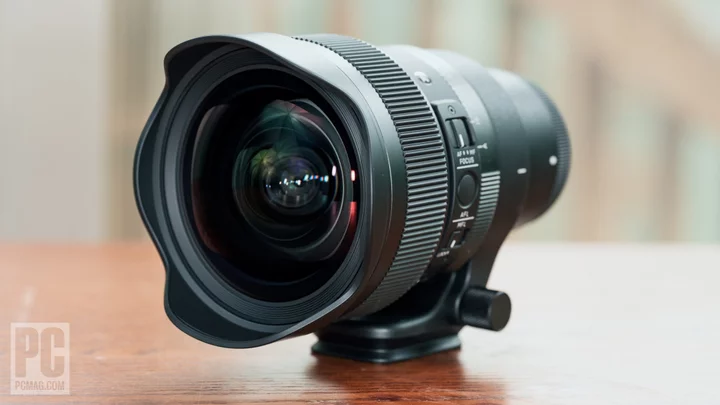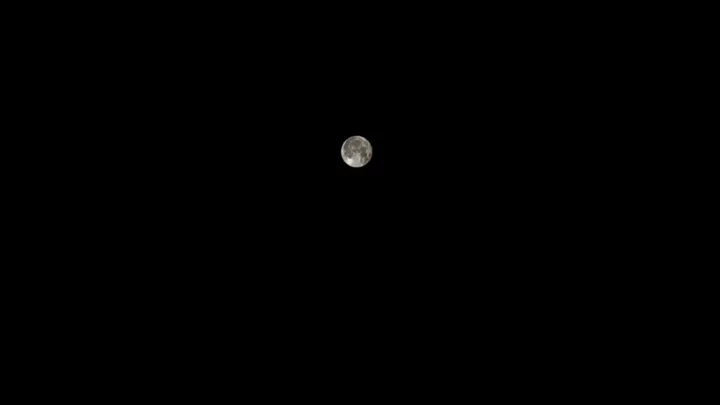Astrophotography is one of the corners of the photo world that calls for specialized equipment, and the Sigma 14mm F1.4 DG DN Art ($1,599) fits that niche because of its bright maximum aperture, weather-sealed design, excellent handling of flare, manual focus lock, and heat retainer. The lens is also a good choice for landscapes, cityscapes, and other wide-angle subjects. However, the Editors' Choice-winning Sigma 20mm F1.4 DG DN Art ($899) is more compelling because of its significantly lower price and similarly tuned optics.
Ultra-Wide Angle and Aperture
The Sigma 14mm F1.4 DG DN Art is the first lens we've seen with such a wide angle and aperture on a full-frame system. Sigma had a 14mm F1.8 DG HSM Art in the SLR days, and Sony markets the FE 14mm F1.8 GM ($1,599.99) today, but night sky photographers chase faster glass to help keep ISO and shutter combinations reasonable, as well as to more easily set focus. The Sigma 14mm is available for Sony cameras, as well as for L-Mount Alliance bodies.
The combination of a big f-stop and ultra-wide view makes for a hefty lens. The 14mm F1.4 DG DN Art's 19-element, 15-group optical formula results in a 5.9-by-4.0-inch (HD) barrel and 2.6-pound weight. It's a heavy lens to carry, especially if you've got others in your bag. If you don't mind giving up a half-stop of light, the Sony FE 14mm F1.8 GM is downright small by comparison (3.3 by 3.9 inches, 1.0 pounds). For reference, Sigma's 20mm F1.4 DG DN Art comes in at 3.5 by 4.5 inches, and 1.4 pounds.
Sony touts the FE 14mm F1.8 GM for astro work and it tests well for that discipline, but Sigma leans further into astro features here. The Sigma 14mm F1.4 is just as good at suppressing sagittal coma as the company's 20mm F1.4 lens in the field, for instance. And, like the 20mm, it includes a manual focus lock and incorporates a heat retainer into its barrel (meaning you can add a lens heater to fight condensation without impacting the frame).
Sony a7R IV, f/5.6, 1/100-second, ISO 100The barrel uses a mix of thermally stable composite (a high-grade plastic Sigma says is lighter but just as durable as aluminum) and magnesium in places where metal makes more sense. The 14mm is fully weather-sealed, and the front element includes an anti-smudge fluorine coat, so it's ready for outdoor work. It's too big to support front filters, but the lens includes a rear slot for gels.
Sigma includes a rotating tripod collar with an Arca-Swiss dovetail foot with the lens. You can remove it, but if you plan on using a tripod (a requirement for night sky work), you should use the lens mount as the attachment point, not your camera (the lens is front-heavy). Sigma also includes a rubber beauty ring in the box to replace the collar for those times you don't need it, along with a soft carrying pouch and a slip-on front cap that protects the lens.
One other note: Sigma warns photographers with pacemakers to be careful with the 14mm F1.4. The lens includes a magnet, so you should keep it at least two inches away from your chest to avoid complications. If you’re concerned, you should talk to your doctor about how this might affect your health.
Controls for Night Sky Work
The 14mm F1.4 Art has all of the controls I expect from a modern high-end lens. The on-barrel aperture ring toggles between third-stop detent clicks and smooth, silent turns. It also includes an "A" position if you want to move aperture control to the camera body. The aperture lock switch lets you keep the lens set at either "A" or in its manual range but doesn't go as far as to lock the lens down at a particular f-stop.
It's easy to toggle the focus mode via the AF/MF toggle, and you can use the function button just below it to drive or lock focus, depending on how you set up your camera. The manual focus experience was pleasing, and the bright aperture made it pretty easy to lock focus on distant stars, even with my first-generation Sony a7R IV and its so-so rear LCD. I made sure to engage the Manual Focus Lock switch once I had focus set perfectly, which gave me the freedom to move my tripod around and try different frames.
Sony a7R IV, f/1.4, 10 seconds, ISO 100Autofocus is as quick as I've seen on the a7R IV. The 14mm F1.4 uses a linear HLA focus motor that racks focus instantly and silently. The lens calls for a serious gimbal like the DJI RS 3 for video work but does a good job for point-of-view and other special effects shots. Some focus breathing is visible, however: The angle of view is slightly wider when you focus on a nearby subject. You might notice the change in rack focus shots that shift perspective for dramatic effect, but it won't detract from takes with moderate shifts to focus.
Sony a7R IV, f/1.4, 1/1,000-second, ISO 100Despite a design tilted toward night sky work, the 14mm F1.4 does a decent job with close-up subjects (even though it falls well outside of the macro realm). It focuses as close as 11.8 inches away from the sensor for 1:11.9 reproduction. The broad view makes for interesting close-up effect shots that show an especially broad range of your surroundings. The working distance from the front element is around three inches, though, so make sure not to shade your subject.
Sigma 14mm F1.4 Art: In the Lab
I tested the 14mm F1.4's resolution using our standard method—tightly framing and photographing a transmissive SFRPlus test chart. There's a slight complication in this case though: You must perform this test at a close distance with a wide lens and Sigma's technical documentation cautions that the lens doesn't perform as well at focus distances of less than 6.6ft (2m). This makes sense because test charts are flat, and the 14mm's bulbous optics capture a field of focus with a decided curve. As a result, sharpness results away from the center are artificially low. This characteristic is not a problem when you focus on distant objects (the stars in the night sky are more than a couple of meters away). And for closer subjects, either using a wide aperture to induce background blur or increasing the depth of field mitigates this issue.
Sony a7R IV, f/5.6, 1/125-second, ISO 100At f/1.4, the 14mm shows an excellent 4,400 lines at the center of the Sony a7R IV's 60MP sensor. Off-center sharpness drops quickly, as I expect from a lens with field curvature. The center gets better at f/2, showing an outstanding 5,000 lines, and maintains that level of quality through f/11. There's a drop in picture quality at f/16, a result of diffraction, but I still see very good results (4,000 lines) in the central area of the frame. You might still want to stop all the way down to get sunstars; the 14mm draws crisp 22-point starbursts at its minimum aperture.
Sony a7R IV, f/1.4, 1-second, ISO 400To supplement the close-up lab charts, I made some boring images of a wide paved walkway, with the point of focus set further out. In this sequence, the lens shows softness at the edges and corners at f/1.4 and f/2, but edges are clear starting at f/2.8, and tack sharp from f/5.6-11. Thus, the 14mm F1.4 is more than capable for landscapes.
At wide apertures, the 14mm F1.4 handles backlit situations and flare quite well. I made some images into the sun with it just out of frame and the integrated hood and anti-reflective coatings helped images maintain good contrast. I couldn't spot any evidence of ghosts or false color at wide apertures, but I did notice some reflections when I tested at f/16 for sunstars.
Sony a7R IV, f/16, 1/50-second, ISO 100The optics show some barrel distortion and a vignette without corrections or a Raw profile. You won't have to worry about this if you use your camera in JPG mode, but for Raw photography, make sure to enable any correction profiles to brighten edges and eliminate visible barrel distortion.
I also used the lens for some night sky photography: The lens is a technical star here (pardon the pun). It draws stars in the night sky as perfect pinpoints through most of the frame. I can spot some sagittal coma at the corners of the frame, an effect that draws stars as crosshatches with some false color rather than a pinpoint of light, but it's no worse here than it is with the 20mm F1.4 DG DN Art. The biggest challenge I had was finding an interesting frame. The trees in my yard are a little too dense for an unobstructed view of the sky, and suburbia doesn't lend itself to epic astro-landscape shots like you get from the dark, open skies of more remote locales. It's a real shame that I couldn't try this one out at Arches or Yosemite.
Sony a7R IV, f/5.6, 1/250-second, ISO 100At near distances, it's possible to induce some background blur. A 14mm is not my first choice for close-ups because it's hard to find an angle that doesn't introduce a distorted perspective, but you can certainly use it for a blurred background effect. The defocused highlights, or bokeh, is very pleasing: They are rounded, have soft edges, and are free of distracting onion skin and LoCa false color.
An Ultra-Wide Lens for Night Sky Photographers
There's good reason for astrophotographers to get excited about the Sigma 14mm F1.4 DG DN Art. The lens is the broadest full-frame optic with an f/1.4 aperture for any system, and its on-barrel controls suit night sky work well. It also focuses quickly, shows minimal sagittal coma, and is fully weather-sealed. For the same price, the Sony FE 14mm F1.8 GM is more practical to carry, but it doesn't have as many astro-specific features such as a manual focus lock. Therefore, Sigma's 20mm F1.4 DG DN Art remains our Editors' Choice winner for astrophotography primes; it's a lot more affordable than either of the aforementioned 14mm lenses and still covers a wide angle.
Those are all specialty lenses for astrophotography, though. If you don't care about night sky photos, the Editors' Choice-winning Sigma 14-24mm F2.8 DG DN Art ($1,199) is a more practical ultra-wide zoom that's also available for both E- and L-mount. And Sony owners can go even wider with the FE 12-24mm F4 G OSS ($1,774.99).









